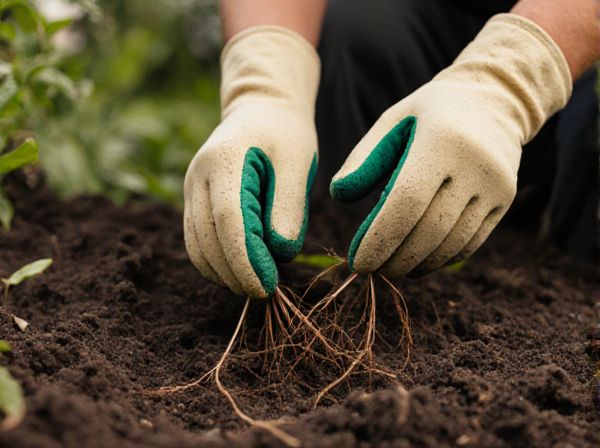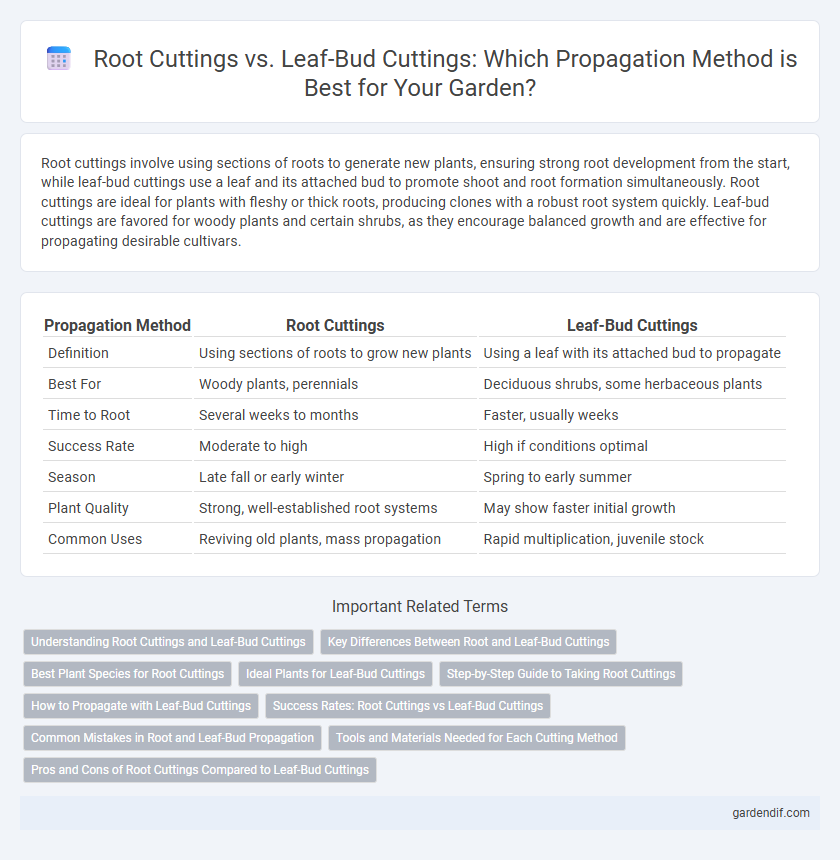
Root cuttings vs Leaf-bud cuttings Illustration
Root cuttings involve using sections of roots to generate new plants, ensuring strong root development from the start, while leaf-bud cuttings use a leaf and its attached bud to promote shoot and root formation simultaneously. Root cuttings are ideal for plants with fleshy or thick roots, producing clones with a robust root system quickly. Leaf-bud cuttings are favored for woody plants and certain shrubs, as they encourage balanced growth and are effective for propagating desirable cultivars.
Table of Comparison
| Propagation Method | Root Cuttings | Leaf-Bud Cuttings |
|---|---|---|
| Definition | Using sections of roots to grow new plants | Using a leaf with its attached bud to propagate |
| Best For | Woody plants, perennials | Deciduous shrubs, some herbaceous plants |
| Time to Root | Several weeks to months | Faster, usually weeks |
| Success Rate | Moderate to high | High if conditions optimal |
| Season | Late fall or early winter | Spring to early summer |
| Plant Quality | Strong, well-established root systems | May show faster initial growth |
| Common Uses | Reviving old plants, mass propagation | Rapid multiplication, juvenile stock |
Understanding Root Cuttings and Leaf-Bud Cuttings
Root cuttings involve using sections of a plant's root to generate new growth, capitalizing on the root's stored nutrients and ability to sprout shoots. Leaf-bud cuttings utilize a leaf blade attached to a stem segment containing a dormant bud, which develops into a new plant through the activation of that bud. Understanding these methods reveals that root cuttings primarily regenerate from underground structures, while leaf-bud cuttings depend on above-ground parts for propagation success.
Key Differences Between Root and Leaf-Bud Cuttings
Root cuttings involve using sections of a plant's root to propagate new growth, typically resulting in robust, independent plants well-suited for woody species. Leaf-bud cuttings combine a leaf blade with a dormant bud, promoting shoot and root development simultaneously, commonly applied in softer-stemmed plants. Key differences include the origin of the cutting tissue, rooting time, and plant types best propagated, with root cuttings often producing more vigorous root systems and leaf-bud cuttings enabling faster shoot emergence.
Best Plant Species for Root Cuttings
Root cuttings are particularly effective for herbaceous perennials such as hostas, phlox, and primroses, which regenerate vigorously from underground stems. These species possess thick, fibrous roots that store ample nutrients, promoting rapid new shoot development. Root cuttings ensure genetic consistency and faster establishment compared to leaf-bud cuttings in plants like horseradish and hellebores.
Ideal Plants for Leaf-Bud Cuttings
Leaf-bud cuttings are ideal for plants with woody stems and well-developed buds, such as roses, camellias, and certain fruit trees like apples and cherries. These cuttings allow for the propagation of specific cultivars while maintaining genetic fidelity and promoting faster rooting compared to root cuttings. Leaf-bud cuttings are especially beneficial for species where root cuttings are less effective or impractical due to root structure or growth habits.
Step-by-Step Guide to Taking Root Cuttings
Root cuttings involve carefully extracting sections of healthy roots, ideally 2 to 4 inches long, from mature plants during their dormant phase. These cuttings should be planted horizontally in a well-draining propagation medium, maintaining consistent moisture and moderate temperatures around 65-75degF to encourage root and shoot development. Monitoring regularly for new growth and ensuring indirect light exposure can significantly increase the success rate of root cutting propagation.
How to Propagate with Leaf-Bud Cuttings
Propagate plants using leaf-bud cuttings by selecting healthy shoots with one or two leaves and a visible bud at the base. Trim the cutting just below the bud and plant it in a moist, well-draining medium to promote root development. Maintain consistent humidity and warm temperatures to encourage successful rooting and growth.
Success Rates: Root Cuttings vs Leaf-Bud Cuttings
Root cuttings generally exhibit higher success rates than leaf-bud cuttings due to their established vascular systems, which facilitate quicker nutrient uptake and root development. Leaf-bud cuttings often face slower rooting processes and require more controlled environmental conditions to achieve comparable survival. Studies show root cuttings can achieve success rates upwards of 70-80%, while leaf-bud cuttings typically range between 40-60% under optimal conditions.
Common Mistakes in Root and Leaf-Bud Propagation
Common mistakes in root cuttings include using old or damaged roots, which reduces the chance of successful rooting, and improper planting depth that leads to rot or drying out. In leaf-bud cuttings, errors often involve selecting leaves without a viable bud or failing to maintain adequate humidity, resulting in poor shoot development. Ensuring clean cuts and using sterile tools are essential practices for both methods to prevent disease and enhance propagation success.
Tools and Materials Needed for Each Cutting Method
Root cuttings require sharp pruning shears or a knife, rooting hormone powder or gel, well-draining potting mix, and containers for planting. Leaf-bud cuttings need a sterile cutting blade or scissors, rooting hormone to enhance root development, a moist, well-aerated growing medium such as peat or perlite, and humidity covers to maintain moisture levels. Both methods benefit from clean, sanitized tools to prevent infection and ensure successful propagation.
Pros and Cons of Root Cuttings Compared to Leaf-Bud Cuttings
Root cuttings offer the advantage of producing genetically identical plants with a higher success rate in species that root readily, allowing for rapid propagation of mature root systems. However, root cuttings require careful extraction to prevent damage and often need a longer establishment period compared to leaf-bud cuttings, which can propagate faster and with less risk of transplant shock. Leaf-bud cuttings facilitate easier handling and are suitable for species with less robust roots but may result in lower survival rates and slower initial growth relative to root cuttings.
Root cuttings vs Leaf-bud cuttings Infographic

 gardendif.com
gardendif.com